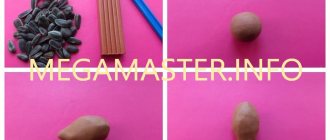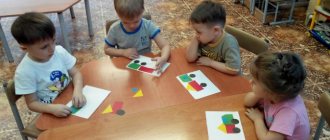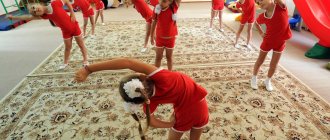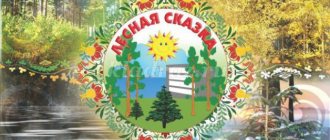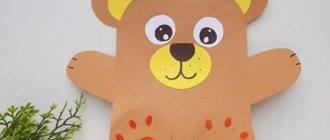Summary of a modeling lesson for the senior group
Summary of a modeling lesson in the senior group.
Topic: “Kinder toys”
Fefilova Irina Petrovna
Target:
Strengthen skills in working with plasticine, develop the ability to use waste material in modeling.
Educational areas:
cognitive development, artistic and aesthetic development, social and communicative development
Objectives: 1. Cognitive development.
Develop imagination and creativity.
2. Artistic and aesthetic development.
Develop the ability to conceive the content of your work and bring it to completion.
Strengthen the ability to use previously mastered sculpting methods, achieving expressiveness in the image of the intended animal. 3. Speech development.
Expand children's vocabulary, develop dialogical speech.
4. Social and communicative development.
Develop positive attitudes towards various types of creativity.
To develop children's communication and interaction with adults and peers. Preliminary work:
looking at pictures of animals.
Material:
multi-colored capsules from kinder surprises, plasticine, stacks, cardboard stands, boards for modeling for each child.
Progress: Educator:
Guys, do you like sweets?
What's your favorite treat? (children's answers). Educator:
If you love Kinder surprises, you probably have empty Kinder eggs somewhere in your house.
You can throw away this waste material, or you can look at it and figure out where you can use these capsules (children's answers). Educator:
If you fill Kinder containers with various fillings, for example: peas, buckwheat, rice, they will turn into a rattle for small children, or even into a musical instrument (the teacher shows a capsule filled with cereal).
Educator:
In such capsules it is also convenient to store various little things that can easily get lost: beads, beads, small buttons.
Educator:
There is another interesting and simple idea - string empty kinder eggs onto fishing line or wire.
This will make a wonderful garland; you can decorate your Christmas tree with it for the New Year. Single-color eggs can be painted with paints. If you draw funny faces on our kinder eggs, you will get charming emoticons, bees, and minions. Educator:
Or maybe some of you know the most well-known idea for colds and flu?
(the capsule is filled with pieces of garlic, holes are made in it and attached to a string). Educator:
You can also make a “snake” craft from Kinder eggs: insert one half into the other, using several capsules.
Advertisement 05
Educator:
Each Kinder egg can be turned into an animal.
How do you think? (you can paint an animal on an egg, you can sculpt it from plasticine). Educator:
Only the paints needed are not watercolors or gouache, but acrylic ones, because the capsules are plastic, and ordinary paints do not stick well to plastic.
The teacher leads the children to the fact that Kinder eggs can be used in modeling. Educator:
Today we will turn our capsules into animals using plasticine.
Let's look at a kinder egg and figure out what kind of animal we can turn it into. For example, let's add eyes, a nose, long ears, four legs - and before us is a cheerful...who? (bunny). Educator:
What other animals can we sculpt?
(children's answers). Each animal has its own distinctive characteristics. Riddles will help us remember them: Good-natured, businesslike, Covered with needles... Can you hear the patter of nimble legs? This is our friend... (hedgehog) This animal is somehow strange: Its neck is like an arrow from a crane. To reach the herbs with your mouth, it will fold in half... (giraffe) Cunning cheat, Red head, Fluffy tail - beauty! And her name is... (fox). What a miracle! What a miracle! A dish on top, a dish below! A miracle walks along the road, its head sticks out and its legs stick out. (Turtle) A log is floating in the river, It really wants to eat. The evil, green one opened his toothy mouth... (Crocodile) Don’t touch him with your hand! He has a mane, but he is not a horse. There are no hooves, but there are fangs and claws on the paws. (Lion) Educator:
Guys, choose a capsule of any color and turn it into an animal. During the work, the teacher guides the children’s actions, if they experience difficulties, and helps with advice. Children place their works on cardboard and put them on display.
GCD summary. Modeling “Hedgehog” in the senior group of preschool educational institutions
The plan is a summary of the GCD in the senior compensation group. Topic: “Hedgehog” (plasticine modeling)
Author: Tsutserova Natalya Alexandrovna.
My work may be useful for kindergarten teachers and additional education teachers. Integration of educational areas : cognitive, speech, communication, artistic - aesthetic, physical. Goal: teach children to sculpt wild animals. Objectives: Cognitive development: • Develop interest in wild animals. • Expand knowledge about hedgehogs: appearance, lifestyle, nutrition. • Learn to understand the relationships in nature. • Respect for nature. Social and communicative development: • Clarify knowledge about the rules of behavior in nature. • Develop independence when performing work. • Develop the ability to work together with peers. Speech development: • Develop the ability to perceive fiction. • Develop sound and phonemic hearing. • Develop connected, interactive speech. • Develop the ability to answer questions with complete answers. • Practice onomatopoeia. Artistic and aesthetic development: • Teach children to sculpt a hedgehog, conveying the characteristic features of its appearance, and complement the image. • Develop an interest in working with plasticine. • Develop an aesthetic attitude towards the surrounding world. • Develop fantasy and imagination. Physical development • Develop fine motor skills of the hands. • Prevent children from becoming tired. Methods and techniques. • Gaming: didactic, verbal games.
• Practical: examining a sample, doing the work independently. • Visual: showing and explaining the work • Verbal: situational conversation, questions, explanations from the teacher. Materials: plasticine (beige, brown, gray), napkins, seeds. Progress of the lesson.
- Guys, let's play!
The game is called "Football". Children throw a ball to each other and name forest animals. Surprise moment: - Look, guys, someone brought a basket. I wonder what's there? (teacher raises handkerchief) - Note! (Reading) Angry touchy lives in the wilderness of the forest There are a lot of needles, But not one thread. (Hedgehog)
- Right. Look what a beautiful hedgehog! “Once, a hedgehog I knew told me the following story. When he was very small, he had blind eyes, deaf ears, and no needles at all. The hedgehog's mother would not let him go far from her until good, strong needles appeared. The hedgehog has a lot of needles, which are renewed every 3 years. He has 36 teeth. When hunting, he relies only on hearing and smell, as his eyesight is very poor. — What do you think hedgehogs eat? — Hedgehogs feed on insects, small birds, bird eggs, lizards, berries, snakes, frogs. — Do hedgehogs have enemies? — Of course, there are eagle owls, large owls, hawks, and foxes. — What do hedgehogs need needles for? - Yes, guys, hedgehogs need needles for protection. The hedgehog is capable of curling up into a tight ball, with its spines exposed; it hisses and twitches strongly, jumping up if you touch it. -Let's try to become hedgehogs. Breathing improvisation “Hedgehog” - The hedgehog wrinkles his nose, bites his lower lip, and pronounces the sound “fff”. — The hedgehog wrinkles his eyebrows and pronounces the sound combination “puff-puff-puff.” - The hedgehog puffs out his cheeks, then exhales with the sound “pu-u-u” - The hedgehog is tired, exhale through his throat with the sound “ha-a-a” Well done! - Guys, the hedgehog hunts in the summer and breeds offspring. What does he do in winter? - Yes. The hedgehog hibernates. Hibernation lasts 128 days. When he wakes up, the hedgehog is very hungry, so he spends several days searching for food. — How to understand the proverb: “The hedgehog is the nurse of the forest and the ship of the edges.” - Ri. The poem “He’s like a Christmas tree” He’s like a Christmas tree, Covered in needles, Bravely catching scary snakes. And although he is very prickly, don’t you dare offend him. He lives in the forest. But the funny hedgehog also enters the gardens. — Hedgehogs live in the forest. Even in our forests of the Samara region. -Why can’t you take a hedgehog home? - Yes you are right. It really shouldn't be taken home as it is a wild animal and should live in the forest. Hedgehogs are also nocturnal animals. If you take him home, he simply won’t let you rest at night, as he stomps so much. And at home he can die. — If you can’t take a hedgehog home, what can you do? -Made from plasticine. - First, we need to stretch our fingers. Physical education Hedgehog, prickly hedgehog The fingers of two hands are clasped together.
Show the needles.
Movement of the brushes to the right, left.
Here they are, here they are, here they are.
We straighten our fingers, clasp our hands.
Hedgehog, prickly hedgehog
Put them in a castle
Hide your needles. Once, and there are no needles.
Doing practical work:
1. Warm the plasticine with your palms 2. Roll out the body of the hedgehog. From one edge we make the shape of a muzzle, a sharp nose.
3. From the side of the muzzle, we begin to insert the seeds with the sharp side into the plasticine.
4. When you reach the end of the hedgehog's back. Make sure that the plasticine is not visible from behind.
5. Make eyes and nose.
Reflection. - What wonderful work you have done! - Let's look at them.
We recommend watching:
Summary of GCD in the senior group. A journey through Chukovsky's fairy tales. Notes on direct educational activities in the senior group for children with mental retardation. Notes on cognitive and research activities in the senior group. Notes on educational activities in the senior group on the topic “How to see the air.”
Similar articles:
Summary of a safety lesson in the senior group: Safety in nature
Lesson on basic safety in the senior group. Topic: Rules of conduct while walking
Life safety tasks for children 5-7 years old
Program content. Teach children to make musical instruments from waste materials. Strengthen children's ability to perform familiar operations with scissors and glue. Develop fine motor skills of the fingers. Cultivate an interest in manual labor and a desire to achieve results.Materials: yogurt cups, ribbons, beads, laces, felt-tip pen cases; sockets with glue, brushes, oilcloths, napkins, phonogram “Morning”, magic wand, tiara, tape recorder, patterns for making crafts for each child.
Progress of the lesson
Children stand in a circle. The Music Fairy enters to the music.
Fairy. Hello children! I am the Fairy of Music. Today we will go to the wonderful world of music.
I’ll draw a bow across the strings and immediately find myself in a fairy tale. A wonderful instrument will help me, It can sound in different ways: Sometimes tender, affectionate, light, sometimes low, juicy, deep. He sings with a velvety sound and immediately touches the soul.
Fairy. Try to be silent for a while, listen...the whole world around you is filled with sounds. They are different. Tell me what do you hear?
Children. Water is dripping, the wind is blowing outside the window, like a mouse scratching somewhere.
Fairy. What sounds are these?
Children. Voiced, dull, quiet, loud, ringing, creaking.
Fairy. Yes. Some are like music, others are like noise. Sounds can be produced with the voice or with musical instruments. Thanks to this, musicians and composers depict characters, sounds of nature, birdsong and even weather phenomena in their works. Now you will see for yourself (listening to the melody “Morning” by E. Grieg).
Fairy. What did you imagine when you listened to this music?
Children express their ideas.
Fairy. You know how to listen to music, but do you know musical instruments?
Puzzles:
In our orchestra there is a little bit of everything Ringing... (bell), Singing... (accordion). Our orchestra has a little bit of everything. Both the tambourine and... (spoons) play.
His teeth are white and black, but he doesn’t go to the doctor. Without him, not a single holiday in kindergarten takes place. (Piano)
It grew in the forest, was taken out of the forest, cries in your hands, and whoever listens jumps. (Horn)
In the forest, knock-knock, In the hut, blunder-blunder, In the hands, clang-clunk, On the floor, clatter-clop. (Balalaika)
Wrinkled tit makes the whole village happy. Without him, you can’t sing a song, or dance. (Harmonic)
From dawn to dusk the spooners are having fun. Voiced, carved Play painted. (Spoons)
It's not thunder, it's thundering, but that's why it's famous. (Drum)
Fairy. Do you have musical instruments in the group?
Children. Yes!
Fairy. Which ones?
Children. Drum, metallophone, piano, maracas, spoons, rattles, tambourine.
Fairy. You have a lot of instruments, but let's make some that you don't have in the music corner. I have a wonderful book, it contains a lot of musical instruments that you can make with your own hands. (Shows illustrations, children sit at tables).


